| Columns Retired Columns & Blogs |
Maybe this is a dumb question but why do we see no pre-ringing from the anti-aliasing filter?
To measure the record/replay frequency response, the machine was run at the standard 48kHz sampling rate without preemphasis. It held to a +0.1, –0.35dB tolerance from 20Hz to 20kHz (fig.12), while the –0.5dB points were wide at 2Hz and 22kHz. In record "monitor" mode, the response was a little tighter at ±0.15dB. The brickwall filter point occurred at 24kHz. Channel matching was excellent, typically within 0.1dB, while channel separation exceeded 95dB over the audible range.
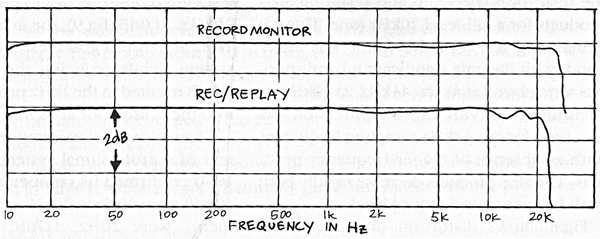
The full-level midband harmonic distortion was considered excellent at –90dB, 0.003%. With the input level turned down to –60dB (fig.13), the analyzed distortion spectrum showed no visible harmonics. The computed reading was –47.62dB, but this was merely noise.
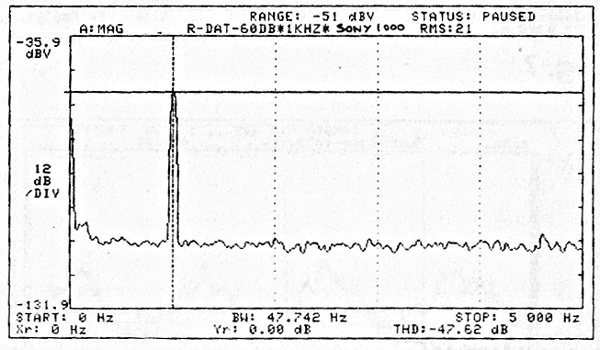
Given a theoretical 96dB dynamic range for a 16-bit system such as this one, the measured distortion for a tone at –60dB should be –36dB, yet nothing can be seen (fig.13) at –50dB, below the measurement noise floor. This is reminiscent of the PCM 1630's use of linearizing dither. Checking the DTC-1000 for record/replay transfer linearity, we got the results in Table 2. Again, as with the 1630, if a 16-bit system "stops" at –96dB, how come these machines can encode and decode accurately at –110dB? Certainly a straightforward 16-bit linear system could not do this, but neither the 1630 nor the 1000 are such systems.
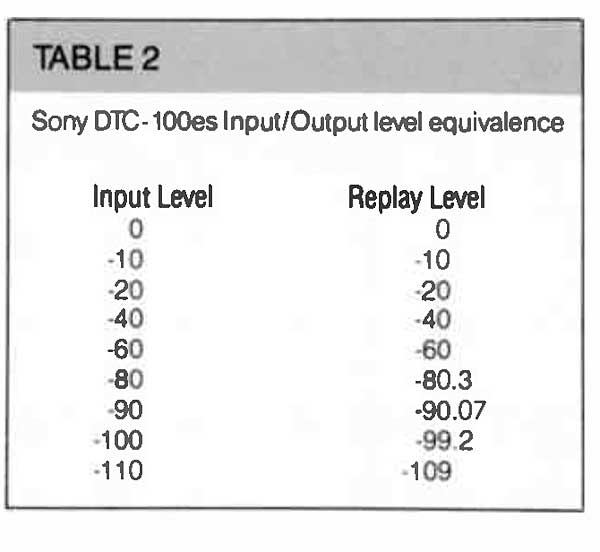
With dithered encode, the effective linearity is improved by the order of 3 bits, or 18dB, while both machines offer better than 16-bit replay via oversampling, 2x for the 1630, 4x for the DTC. Even so, this still does not fully account for the excellence of the low-level resolution featured by these machines. I cannot see now how objections to the low-level linearity and resolution of digital can be sustained, at least regarding machines such as these, since it is so clearly superior in this respect when compared with other media.
To confirm the R-DAT's resolution, a sinewave was recorded at –90dB. Fig.14 shows that on replay, a real sinewave, albeit noisy, is returned. Few CD players can match this performance.
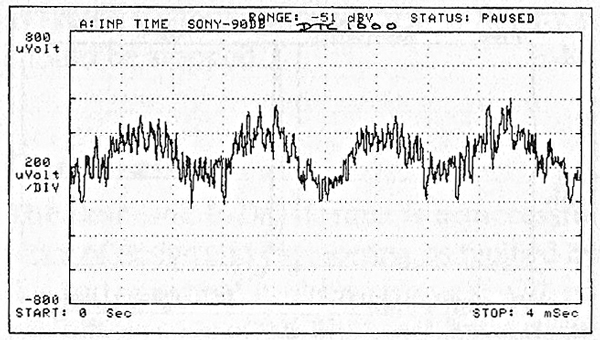
To check the high-frequency performance, the recorder was driven to 0dB at 20kHz, with a fine result (fig.15). The main modulation product at 8kHz (48kHz–2×20kHz) was well suppressed at –77dB, and decreased very rapidly with decreasing input frequency. However, the ultrasonic (inaudible) product at 28kHz (48–20) was at a higher level of –53dB. Complementary measurements for two-tone high-frequency intermodulation gave equally fine results: –74dB for full level and –82dB at a –10dB test level. Using a –60dB 1kHz "signature," the spurious upper-range signals were assessed up to 100kHz. 48kHz was the sole component of significance, set at a fine –100dB, relative to full modulation.
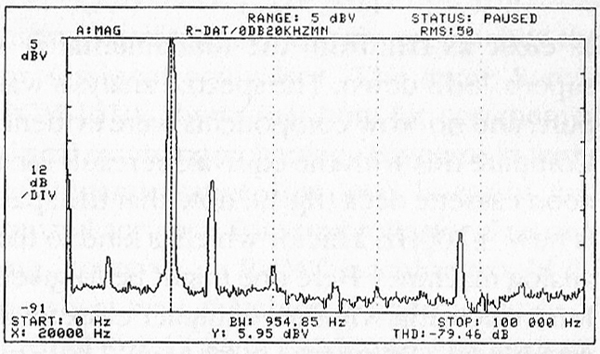
The machine delivered an unweighted record/replay S/N ratio of 91dB; this was 93dB with CCIR ARM (1kHz) weighting, which compares favorably with the professional machine. Moreover, the overall linearity and resolution figures were also comparable, with full-scale resolution approaching 15.5-bit, and an effective low-level linearity of near 17-bit.
Absolute-phase correct, the DTC-1000 also showed negligible phase shift between channels, with a maximum of 1° noted at 20kHz. The 400Hz squarewave response (fig.16) revealed a most tidy result, non-linear phase, but with quite moderate ringing and overshoot (18%). An extended low-frequency response with low associated group delay was indicated by the waveform "squareness."
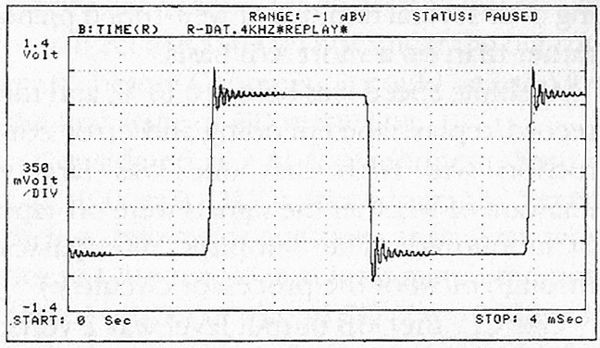
Digital recording systems have been criticized in the past for poor clipping performance. The DTC1000 was driven into clip with a 1kHz signal: fig.17 shows the replay result. As can be seen, there are no missing codes, no sharp transients or spurious effects—just clean, vice-free, "analog style" clipping. On music it sounded much as it looks here, with a surprisingly mild audible impairment for moderate (up to 6dB) overloads.
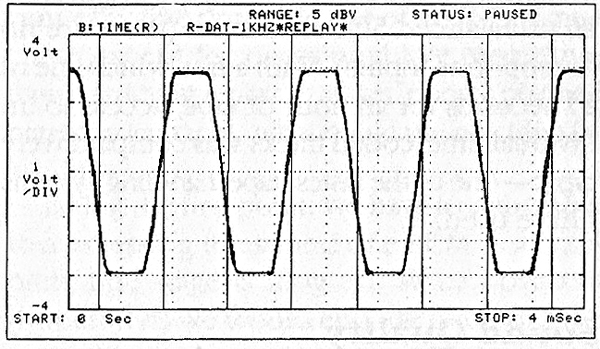
Considering that R-DAT has various technical complications such as servo azimuth and the usual clock/timing reinsertion, it was decided to put the Sony claim for wow and flutter to test: namely ±0.01% weighted peak. With the IEC 62 DIN peak weighting, the record/replay value was established at ±0.005% (±0.002). Given that analog tape systems produce relatively high levels of flutter sidebands as well as modulation noise, and remembering that, potentially, R-DAT represents the domestic cassette standard of the future, a narrow-band spectrum analysis was made of the 3150Hz replayed tone to assess its pitch stability and noise-modulation performance (fig.18). With a total span of 25Hz and an analyzer resolution of just 0.238Hz, the first modulation shoulder was as close as 1Hz from the fundamental at a superb 78dB down. The spectral analysis was pure, and no wow components were evident. Compare this with the equivalent result for a good cassette deck (fig.19: note that the span is now ±200Hz, a factor which is kind to the analog machine). Here one might be forgiven for wondering whether compact cassette is capable of holding true pitch at all! I believe that these differences are audible, aurally telling over several minutes of well-tuned piano rather than on a short A/B basis.
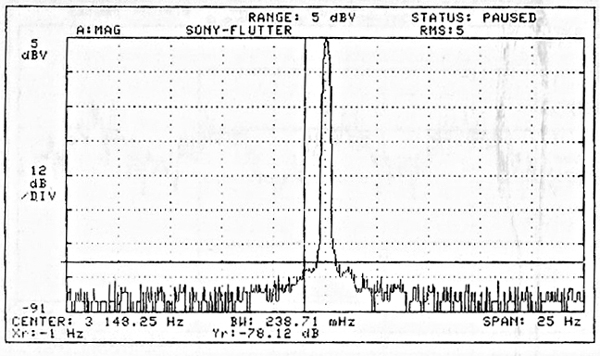
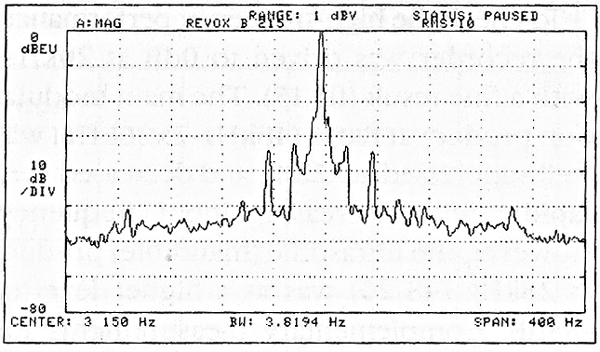
Absolute speed was held at 0.01%, and the record/replay tape encoding and error correction was such that one was largely unaware of whether the signals were off-tape or monitored. (The "monitor" line passes through most of the processor circuitry.)
Like CD, the 0dB output level was 2 volts, sourced from a low 364 ohms. A 300mV input will drive the DTC-1000 to full modulation via an unbalanced 50k ohm input (there are no microphone inputs). With a fast-wind time of 27 seconds for an hour of tape, access to individual time-coded tracks was comparatively rapid—one of the fastest tape-handling systems I have used.—Martin Colloms

why do we see no pre-ringing from the anti-aliasing filter?
It's a minimum-phase filter, presumably operating in the analog domain.
John Atkinson
Technical Editor, Stereophile

We sure have come a long way from the 1630 and DAT, thank goodness!
While Apogee's retrofit filters provided an appreciable increase in 1630 performance, the limitations of the 16-bit system, particularly at low levels, could not be overcome.
And though DAT certainly seemed convenient, I found the shelf life to be rather limited. After a few months, many tapes developed sections that played back sounding much like a fax transmission! I wouldn't want to archive to such a format.
Happily, we now have systems that can deliver a superbly clean 24-bit capture at 192 kHz.
When I first heard digital back in early 1983, my feeling was that it took vinyl 100 years to get to where it was, and that in another 100 years, digital will have arrived too. ;-}
I feel most fortunate that we didn't have to wait anywhere near that long.
Best regards,
Barry
www.soundkeeperrecordings.com